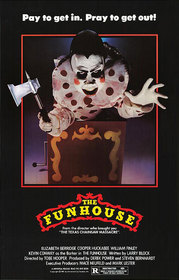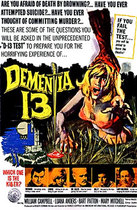Our editor-in-chief Nate Yapp is proud to have contributed to the new book Hidden Horror: A Celebration of 101 Underrated and Overlooked Fright Flicks, edited by Aaron Christensen. Another contributors include Anthony Timpone, B.J. Colangelo, Dave Alexander, Classic-Horror.com's own Robert C. Ring and John W. Bowen. Pick up a copy today from Amazon.com!
The Funhouse (1981)
Carnivals. Carnivals filled with clowns and cotton candy, merry go rounds and barkers, game booths and freakish sideshow oddities. What is their appeal? Why are we so afraid of these malevolent and dark settings, but are so attracted to them at the same time? What is it about their colorful and bright atmospheres that make them so inviting and enjoyable, but yet so bizarre and arcane? This is part of why carnivals make the perfect setting for any great horror movie, because they capture exactly just what we love about them: being frightened and having fun at the same time. Director Tobe Hooper, who shocked us all with The Texas Chain Saw Massacre, understood this well, and utilizes this place of charm and fear to his advantage, creating a creepy and menacing cinematic experience that is The Funhouse.
Amy Harper (Elizabeth Berridge) goes on a double date to the local traveling carnival with her date, Buzz Dawson (Cooper Huckabee) along with her two friends, Liz Duncan (Largo Woodruff) and Richie Atterbury (Miles Chapin). At first, they seem to be having a great time there. They go on many of the various rides, play the assorted games, view a magic show, visit a sideshow exhibit, etc. Then Richie has the idea of spending the night in The Funhouse, a popular dark ride at the carnival, for kicks. But everything drastically changes as they witness a horrific murder, and are hunted throughout the foreboding place by a mad barker (Kevin Conway) and his deformed son Gunther (Wayne Doba). Now, Amy and her friends must escape from The Funhouse, which has now been turned, as the tagline says, into a carnival of terror.
There are several aspects to be praised about this particular horror gem, but two of the most striking to the eye are the production design and the anamorphic widescreen cinematography, which elevate the movie from a simple slasher film into a stylish art house film. All of the set pieces look like they came from a vintage 1950s carnival. The several animatronic dolls (like the clown or the executioner) and sprung shock props (like the plastic skeleton or the spider) in The Funhouse always deliver a nice jump scare when it's appropriate. The whole meta-artificial feel of The Funhouse in itself is both enticing and eerie to the audience. And the dark and rich chromatic cinematography of these sets makes all of the bright colors, twinkling lights and gloomy shadows so vibrant and alive. With these visual weapons, Hooper transforms what looks to be an ordinary carnival into a macabre underworld of joy and fright. Much like the Sawyer house in The Texas Chainsaw Massacre, the protagonists become trapped in The Funhouse, almost as if it were a spider web. They have to struggle, fight and possibly kill in order to escape from the web completely. The Funhouse is like another fantastic and unusual world to them, and it's all thanks to the wonderful production design and photography.
The 35 piece orchestral score is vital in constructing the horrific, magical mood. The music adds an additional layer to a bizarre horror movie that's already a sweet, sugary, candy coated treat to the audience. Up until The Funhouse, Hooper has always had a hand in performing the scores for his films (with the noted exception of Salem's Lot's score, performed by Harry Sukman). With The Texas Chain Saw Massacre, there were just screeches and shrieks from string instruments being cut, and with Eaten Alive, there were simplistic jingles of bells and chimes. Both were equally effective scores for those specific films. But in The Funhouse, there are bombastic beats of bass and snare drums, shrill and subtle whistles of flutes and oboes, piercing trills and twangs of trumpets and trombones, and the harmonious melody of the piano. These and the many other musical instruments that develop lovely tension and suspense join together to create a beautiful, moody and operatic score.
The sound also has as much of a punch on the audience's ears as the score does. This was Hooper's first foray into the Dolby Surround Sound system, just before his biggest commercial success with it, Poltergeist. The sound really kicks into effect though when Amy and her friends first enter The Funhouse. All of the cracks of thunder and lightning, bursts of screams and echoing howls of laughter strike so hard that you believe that you're in this anomalous realm, especially when we cut to the POV shots of the teens in the cars. The laughter of the animatronic dolls in particular can be thought of as symbolic, almost as if they're deliberately laughing at Amy and her friends' horrid misfortune. This just aids in giving The Funhouse another degree of ominous ambiance.
The Funhouse has one of the most unique and fascinating creature designs of all 80s horror cinema. Makeup artists Rick Baker (Videodrome) and Craig Reardon (Poltergeist), who would both later go on to work with John Landis on An American Werewolf in London (Baker winning the first Academy Award for Best Makeup), collaborated together to create a truly original and freakish monster. The scene where Gunther rips off his Frankenstein monster mask has just as much horror and shock value as the original unmasking scene in The Phantom of the Opera. It is that mind blowing. Rick Baker once said in a documentary that he hopes to do a makeup design as groundbreaking as Jack Pierce's makeup for the monster in Frankenstein. While obviously this particular design isn't as iconic as the Frankenstein monster (only time will tell), I personally think he accomplished that here. He and Craig Reardon should be given credit and be proud of for thinking outside the box and offering us an imaginative and extraordinary monster makeup from the 1980s.
The monster himself, Gunther, is a character you can't dismiss when talking about this movie. Frankenstein's monster is obviously the original prototype for Gunther. Many would say that it's just because of his external appearance, but let's analyze this for a moment, shall we? First, it can be assumed that he was born from a genetic mutation, through the means of science, as his "brother", Tad, was in a glass jar on display in a hidden part of the sideshow tent, but you can argue otherwise. Second, he is able to make you switch emotions about him in a flash, having several different layers to his character. He's disgusting, but also pathetic. He's physically horrifying, but also misunderstood. And third, he has a rough relationship between him and his "creator" (in this case, his father). He is rejected constantly by The Funhouse barker, who beats him and tells him to never call him father, but also uses him as a homicidal tool when needed. Gunther's relationship with his father correlates back to the overall theme of strong (albeit sick and demented) family values that is prevalent in many of Tobe Hooper's films, particularly in The Texas Chain Saw Massacre. This familiar ground comes to the audience as bolstering while at the same time showing the shock and audacity of their symbiotic affiliation, which is a terrific and equal balance.
The ending of The Funhouse is one that flows with brilliance and disturbance, because it leaves you with a particularly confused and cold feeling. It's astounding how Hooper takes his optimistic characters and sucks all and any hope, life and happiness from them. What is left of them for the audience at the end of the movie is a soulless doll, the hollow shell of what was once a human being. They may be alive, but what's truly left of them? This combined with the sets and props, colors and shadows, music and sounds, and many other features makes The Funhouse a strange and marvelous horror film for all spectators of both darkness and entreating magic.
So, who is brave enough to face the challenge of The Funhouse?
This review is dedicated to the memory of William Finley (Marco the Magnificent). Rest in peace good sir!








